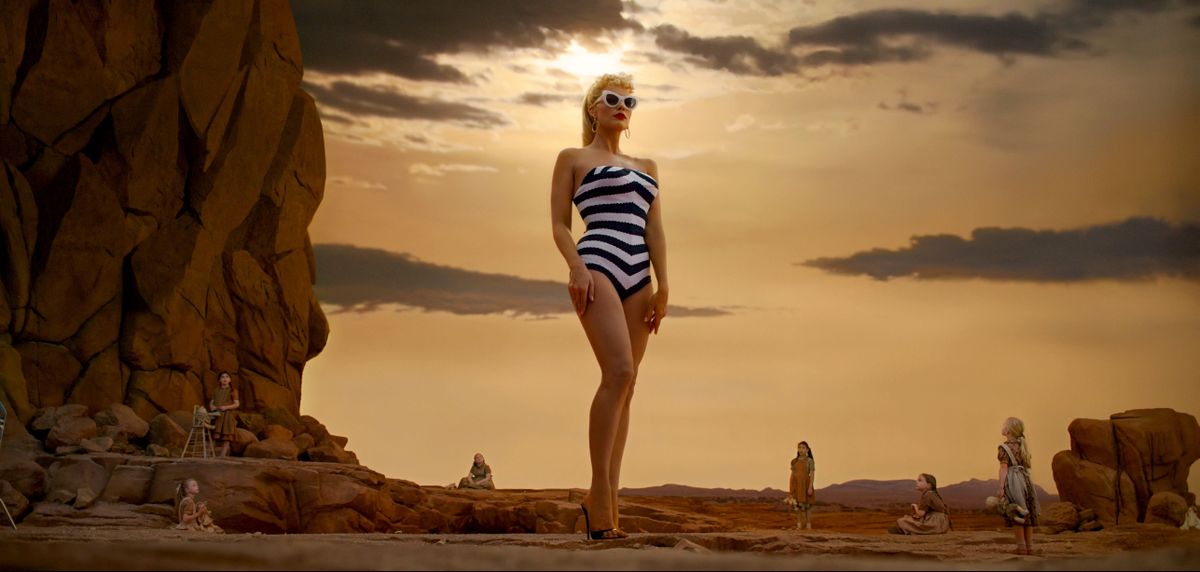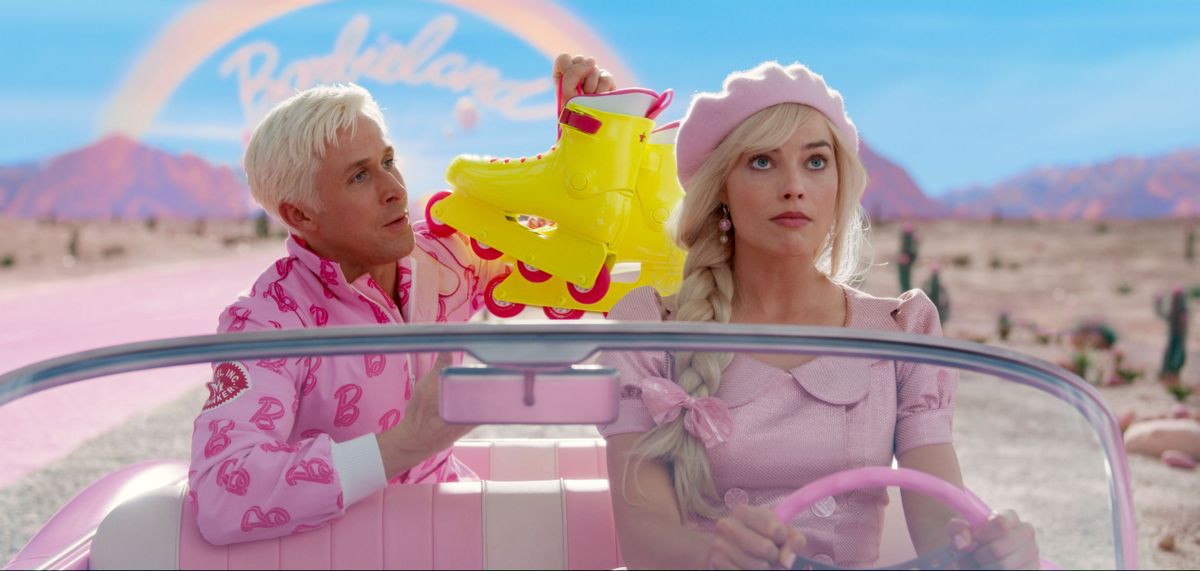Can nostalgia make the Barbie movie a win for Mattel?
Ryan Gosling plays Ken to Margot Robbie’s Barbie in the live-action film “Barbie” set for July release. (Courtesy of Warner Bros. Pictures)
Melissa Reid just needs some workout pants, a leotard and a gold medal to complete her Gymnastics Barbie look in time for the July premiere of the “Barbie” movie.
Reid, 35, and her friends plan to dress up as the Barbies of their youth awash in Barbie Pink, obviously and hit the theater together, a plan echoed widely on social media.
The new film, though not yet rated, isn’t primarily geared at the doll’s youngest fans, experts say. The appeal appears strongest among adults and teens eager to awaken, or at least engage, hazy memories of a beloved toy and peek into the world of Barbie that, too, has grown up.
For doll maker Mattel, the film stands to raise up a 78-year-old brand with wistful Millennials and Gen Xers, and encourage sales of other Barbie-branded products. And it may well plant a seed with viewers to think of Barbie and her Dreamhouse for their kids or young relatives.
Still, it’s a new play for Mattel from a business perspective and a new type of toy movie altogether.
“I don’t think anyone at Mattel is thinking … this is going to sell dolls to 4-year-olds,” said Chris Byrne, a toy industry consultant.
The movie’s trailers have taken the internet by storm since the latest release earlier this month, and spotlighted a star-studded cast that includes Margot Robbie, Ryan Gosling, Simu Liu, Issa Rae, Helen Mirren and Will Ferrell. One clip features bright colors, whimsical fashion and a Barbie setting off on an adventure in her signature pink convertible. Another cements the movie’s self-aware humor: Ken, played by Gosling, suggests he stay the night with Robbie’s Barbie, leading Barbie to ask innocently, “To do what?”
“I’m actually not sure,” Ken answers.
It’s an eye-catching endeavor for its director, Greta Gerwig, who also directed “Lady Bird” and “Little Women.”
At 64, Barbie has had an enduring legacy, emerging time and again from backlash over her appearance as the quintessential doll for children, particularly young girls. She has been a president, an astronaut, the titular character in several animated films and TV shows but this is her first live-action movie.
The decision itself was controversial, said Arpiné H. Kocharyan, an analyst who follows Mattel at UBS Investment Bank. Live-action can be divisive when it comes to toy or animated classics, and some investors worry it might not pay off in terms of sales for the company.
But “Barbie is very different,” she said. “And Mattel management understands the risks and opportunities that come with such an undertaking. So I think this is a major event for Mattel.”
Mattel seems well aware of the potential pitfalls of endorsing a live-action movie. But it also sees the benefits, according to public statements from executives.
“Historically, a live-action movie doesn’t bring the same toy lift that an animated movie would bring,” Mattel’s chief financial officer, Anthony DiSilvestro, said on a call with investors this year. “But the mandate for the Barbie movie is to create great products that people want to come and see in the theater. And in the success, what it will do is just one more element to a very broad franchise approach to Barbie … All the buzz certainly is going to help.”
Mattel declined an interview for this report, citing a quiet period before it releases quarterly earnings on Wednesday. The company said in a statement that while the movie is intended for young adults and older, it expects that dolls, accessories and other merchandising tied to the film will appeal to kids as well.
The stakes are high: Barbie is the largest line in Mattel’s business, which also includes Hot Wheels and Fisher-Price. More than 100 dolls are sold per minute, according to Mattel, which shipped 86 million dolls in 2021.
But Mattel’s profit fell by half last year as inflation took its toll on shoppers while revenue stayed flat; CEO Ynon Kreiz told the Wall Street Journal that sales at retail stores increased during the year. Still, a glut of inventory weighed on the company.
The movie fits right into a trend called “kidulting,” when adults embrace the nostalgia of their youth with coloring books, retro toys and anything that brings a touch of comfort by hearkening back to their youth.
“With these treasured images from their childhood, it’s sort of whimsical to see what would happen if they did grow up,” Byrne said. “It’s both sophisticated and innocent at the same time.”
Mattel hasn’t revealed its exact plan for capitalizing on the Barbie movie fandom, but executives have said on investor calls that it will announce a dedicated toy line that will also appeal to a “collector audience.”
“For older kids and collectors, look for dedicated Barbie movie product, an awesome line that includes premium dolls, die-cast vehicles, games, building sets and a hyperstylish consumer products line,” DiSilvestro said.
With a big toy movie, there would usually be heaps of new toys tied to it, said Laurie Schacht, the chief toy officer of publication the Toy Insider. She doesn’t expect that in this case; instead, she thinks Mattel might release or license merchandise and consumer products apart from its flagship doll line.
“This movie is going to be so dear to adults,” she said. “We might see kitchen items, clothing items. It will be really geared to the adult market.”
And the adults are ready for it.
Stu Szabo, a 25-year-old collector and cosplayer from Western Australia, plans to dress up as Earring Magic Ken a 1990s version of Ken that developed a loyal following but was only sold for a limited time.
“As an adult who collects Barbies and other fashion dolls, it’s really so fun to have a movie that is for the mainstream audience but also has references for someone like me who’ll instantly recognizes the little stuff,” Szabo said in a Twitter message. “The deep cuts of Barbie lore.”
The movie’s vivid colors and takes on classic Barbie outfits has would-be viewers excited to match their wardrobes to the live doll’s styles.
Nichole Gonzalez, a 28-year-old in Columbus, Ohio, never embraced a “girly-girl” style while growing up, she said. But during the pandemic, that changed.
“I kind of found power in the color pink,” she said. “I realize that as a woman or even as a girl it’s okay to wear pink.” She plans to wear the color in some form to the theaters.
Gonzalez never owned a Barbie as a kid, though her sisters did. But now she is contemplating buying one of the dolls especially if she can get her hands on a President Barbie, like Rae portrays in the movie.
That signature color bright, eyecatching Barbie pink is part of Mattel’s play for customers as well. On a recent call with investors, DiSilvestro emphasized Barbie’s wide-ranging cultural impact, including “a global fashion movement that’s not called Pinkcore but Barbiecore.”
Mattel, which has about 15 movies in the works across its brands, emphasized on recent investor calls that it took a “capital-light” approach to this live-action movie, meaning it didn’t invest heavily.
CEO Ynon Kreiz called the movie “emblematic” of the approach for the company’s film division.
“As the IP owner, we don’t just license our brands,” he said on an investor call this year. “We work hand in hand with our partners, from conception to execution, to develop movies and bring them to the big screen.”
The movie might not mean a huge uptick in revenue for Mattel, said UBS analyst Kocharyan.
But it could be good for the company’s profit, she said, because Mattel will make money on royalty fees from licensing the brand to other companies producing Barbie consumer products. The movie could create a kind of “halo effect” around Barbie that could benefit Mattel, she said.
“It will elevate the brand and Barbie is not a typical toy brand,” Kocharyan said. “The DNA is so tied to cultural conversations about self image and fashion and self determination and confidence.”
Barbie also has its detractors, starting with long-held criticisms about its unrealistic proportions and, early on, for not representing races other than white. Mattel introduced a Black Barbie, Christie, in 1968, and has since released a range of diversity within Barbie, featuring different body types, skin tones and hairstyles.
Reid, who is Black, said when she was a kid she had a hard time finding Christie, the Barbie that best reflected her. The Gymnastics Barbie fan is excited about the diverse cast the Barbie movie boasts.
“In a world where media really doesn’t reflect my personal bubble often, its really cool to be able to go to the movies and go back to childhood and also have that representation and not be forgotten,” she said.
Barbie has also become a symbol of confidence and empowerment for women, especially in the past few years as the brand managed to capitalize on the women’s movement, Kocharyan said.
“How they turned that conversation around has actually been pretty incredible,” she said.
The Barbie movie premieres July 21.


